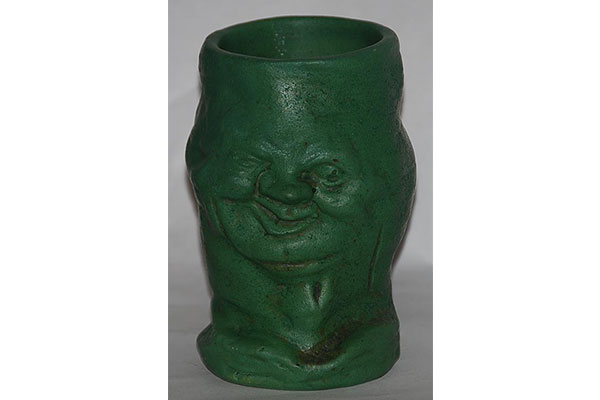Most of us think beautiful florals, dramatic etching efforts and stunning glazes when discussing American art pottery. But this art form isn’t without its unusual pieces.
The Faces in Art Pottery
Art pottery is defined by numerous companies and artists, each of whom brought their own unique take on this line of art. Many artists mastered the beauty of detailed florals, others were experts in glaze lines and shapes. There were those rebels, however, that brought to the table anything but a “flowery” finished look. Many think of George Ohr whenever “rebel” and “art pottery” are used in the same sentence. But there were other streaks of eclectic lines that dot the landscape. Think faces and busts. They’re all quite dramatic and always the conversation piece of any collection.
Weller Dickens Ware, 2nd Line
It’s difficult to find the right adjectives to describe many of the pieces in this line of Weller Pottery. Unusual, exciting and some might say a bit disturbing; not that “disturbing” is used in an insulting manner, it’s just that the tobacco jars that take the shape of very detailed men’s faces can be a bit offsetting.
“The Skull”, as one of the Weller Pottery tobacco jars is called, has no eyes, though appears to be smiling. It can be a bit of a jolt. It’s believed there are three in existence and their value goes up  considerably if you come across one with a finial that is a miniature skull. Another interesting face or bust is found in “The Turk”. The detail is very life-like with a permanent snarl on the fellow’s face, deep-set eyes and flared nose. The dark gloss adds to the dramatic presentation.
considerably if you come across one with a finial that is a miniature skull. Another interesting face or bust is found in “The Turk”. The detail is very life-like with a permanent snarl on the fellow’s face, deep-set eyes and flared nose. The dark gloss adds to the dramatic presentation.
Also in this line you’ll find “The Irishman”. Most likely, there exists an “R.D.” as the signature. This guy has an upturned nose, heavy eyelids, lines around his mouth and thick eyebrows. Let’s just say he’d make a fine addition to your Halloween décor – as long as you keep him in a safe place as his value is considerable.
This is just one line of many that include very detailed faces. It speaks volumes of the talent these artists possessed and talent that they were willing to pour into their creations, unlike many of the manufactured pieces we see in a more contemporary society. To know the history of these Weller pottery pieces is to love them.
If you haven’t visited our Facebook page, be sure to like us and while you’re at, check out our Just Art Pottery Roseville page, too.


